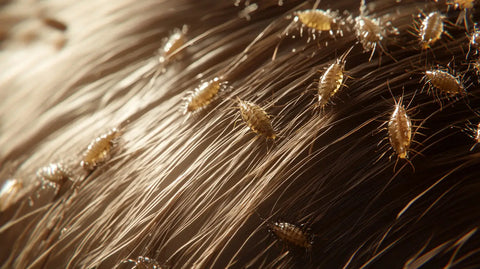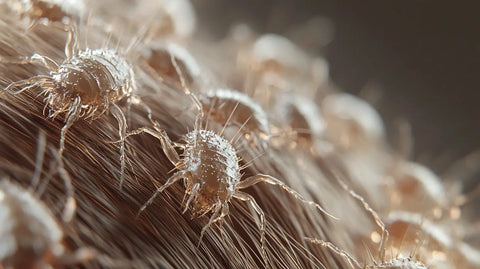How to Calculate How Long You Have Had Lice
Lice are tiny parasitic insects that live on the scalp and feed off human blood. They are spread by head-to-head contact, sharing combs and brushes and other personal items.
The longer a lice infestation goes untreated, the harder it is to get rid of them. Here are a few ways you can calculate how long you have had lice.
-
Observation of Symptoms:
- Monitor the onset and progression of symptoms such as itching and irritation in the scalp.
- Note when you first noticed these symptoms, as they could indicate the presence of lice.
-
Examine Hair and Scalp:
- Regularly check the hair and scalp for lice, nymphs (young lice), or nits (lice eggs).
- The presence of adult lice indicates that the infestation has been ongoing for at least a week or more.
-
Lifecycle of Lice:
- Understand the life cycle of lice, which includes the egg (nit), nymph, and adult stages.
- Lice can survive for about 30 days on a human host, and females can lay several eggs each day.
-
Counting Nits:
- Count the number of nits present in the hair. Nits typically hatch within 7 to 10 days.
- The presence of unhatched nits may indicate a more recent infestation.
-
Hair Growth Rate:
- Consider the average rate of hair growth, which is about half an inch (1.25 cm) per month.
- If you have long hair, the distance of lice or nits from the scalp can provide a rough estimate of the infestation duration.
-
Previous Exposure:
- Recall any recent exposure to individuals with known lice infestations.
- If you've been in close contact with someone who has lice, this could help determine when you may have contracted them.
-
Frequency of Checks:
- Assess how frequently you have been checking for lice. Regular checks increase the likelihood of detecting an infestation early.
-
Treatment Attempts:
- Consider the number of times you have attempted to treat the lice.
- If previous treatments have been unsuccessful, it may suggest a longer-standing infestation.
-
Consultation with Professionals:
- Seek advice from healthcare professionals, such as dermatologists or pediatricians, for a more accurate assessment.
- Professionals can provide insights based on their expertise and may use specialized tools for diagnosis.
-
Document Timeline:
- Keep a timeline or journal noting when symptoms appeared, when you started treatments, and any changes in the lice population over time.
Symptoms
If you find lice on your head or your child's head, there are a few things to keep in mind to help you determine how long they have been there. Lice are parasitic insects that feed on blood and live close to the scalp. They are tiny, gray or tan pests that can be difficult to detect because they move very slowly and are so small. They cannot fly or hop from person to person, so they spread mostly by direct contact. Children most commonly spread head lice to one another through play and by sharing personal items such as combs, brushes, hair accessories and hats.
It usually takes about 4-6 weeks from the start of a lice infestation before symptoms appear, which most often are an itchy head. The itching is caused by the body's reaction to the saliva released by a feeding louse. Head lice can also infest eyelashes and eyebrows, as well as the pubic area.
Because they are parasites, lice need a host to survive. They can't survive more than about two days without a blood meal, which is why washing and isolating belongings is important for prevention. It's also a good idea for family members to avoid head-to-head contact, not share hats, combs or brushes and to be careful when using public facilities such as schools and gyms.
Symptoms of an active lice infestation may include itchy head, sores on the scalp, neck and shoulders and trouble sleeping. Symptoms can be treated with careful nit combing and over-the-counter lice shampoos, but it's important to catch them early before they multiply.
If you notice nits and baby lice (called nymphs) mixed in with the adult lice, this indicates an infestation that has been present for about 2 weeks. This is because the lice have been laying eggs for this length of time. It's also possible to have a longer term infestation, particularly if someone who had lice recently visited you or your child. You should always ask close friends, siblings, parents and caregivers about their lice history to prevent spread.

Nits
Nits are small, oval-shaped lice eggs that female louses lay close to the scalp. They are very close in appearance to dandruff and hair product flakes and can be difficult to see. Nits take 8 to 9 days to hatch into nymphs (babies) and then another 9 to 12 days to mature to adult lice. If you find nits in the hair, it is likely that a case of head lice has been present for some time.
It is also possible to have an infestation and not show any symptoms, especially in children. This is because the body becomes sensitive to the saliva that lice secrete while feeding and can cause itching, but the actual lice are not visible.
Once an adult louse crawls onto a person's head, it can lay about 6 to 10 lice eggs a day that hatch in about 9 days. If you see nits on the head and no live adult lice, you have probably only had an infestation for about 2 weeks.
A mixture of nits and nymphs with some adults is typical of a moderate or severe infestation that has been in progress for 30 days or more. If you find nits that are more than 1/4 inch from the base of the hair shaft, they may be already hatched or non-viable nits or casings.
It is important to check and treat any member of the family, friend or household who might have lice or nits. Also, it is important to wash any sheets, pillows or other items that might have come into contact with the heads of people who might have lice. Washing these items in hot water, as high as 130 degrees F, should kill the lice and nits. In addition, teach your children not to share combs, brushes, hats or other items that they use on their heads with anyone else. They should always be careful when playing with friends or classmates. This will help prevent the spread of head lice. Finally, it is important to not allow anyone with lice to sleep or go to school until they have been treated.

Adult Lice
When the lice mature to adults, they are no larger than a sesame seed and gray-white to tan in color (they may appear darker on people with dark hair). Lice have six legs and feed by sucking blood from the scalp. Adult lice can live up to 30 days, but die within two days if they are removed from the scalp and lose access to their blood supply.
Adult head lice mate and lay eggs, called nits, on the hair shafts. A louse's egg has a sticky substance that firmly attaches it to the base of the hair shaft. Nits look a bit like dandruff and can be difficult to see, especially with the naked eye. They are usually off-white to tan in color and are easier to spot with a magnifying glass or a close-up picture. Each louse can produce up to 10 nits each day.
Lice do not carry diseases, but they are still a nuisance. Itching is a common symptom of lice and can be very uncomfortable. Many people do not experience itching until the infestation has reached moderate to severe levels of activity. Lice can spread to other people through direct head-to-head or body contact, as with children who play together and touch heads frequently.
Detecting head lice and nits early can help you determine how long the infestation has been active and the extent of the problem. It can also allow you to identify other people with whom your child has come into close contact and inform them so they can begin treatment right away.
A lice infestation can be difficult to treat, and the longer it has been active, the more nits there will be and the harder it will be to remove them. Most lice treatment routines involve repeat treatments 9-10 days after the initial treatment and a period of 2-3 weeks to ensure that all lice and nits are dead and gone. Having an idea of how long you or your child have had lice may also help you determine which over-the-counter treatments are likely to be effective and when a prescription medication is necessary.

Detection
Lice are tiny parasitic insects that live close to the scalp and feed on blood. These creatures are spread through head-to-head contact with someone who already has lice, or by sharing combs, brushes, hair accessories, hats and scarves that have been worn by an infested person. They are also spread by sharing contaminated items such as towels, rugs and pillows. Although lice are not considered a medical hazard, they cause itching and can be difficult to remove from the hair. If you have lice, it is important to know how long they have been living on your head.
The itching that occurs when lice are present is caused by the saliva secreted while they are feeding. It is possible to have lice without having an itching reaction, but it is usually easier to spot an infestation once symptoms start. Since lice are small, moving quickly and avoiding light, they can be difficult to find. A magnifying lens and a fine-toothed comb can be helpful tools for detection.
If you suspect that your child has lice, hold the head over a towel and comb through the hair and scalp. If a louse or egg is found, it will be very sticky and firmly attached to the hair shaft. These nits are almost always a dead giveaway of a lice infestation because they will be very difficult to remove once they have hardened. Eggs that are more than 1/4 inch away from the base of the hair shaft may still be able to hatch, but are not likely to do so.
If you see a mix of generations of lice, including baby lice called nymphs, and adult lice, it is probably safe to say that you have had a lice infestation for at least 2 weeks. The longer an infestation has been going on, the more eggs will have hatched and matured into adults, and the more itchy symptoms you may experience. It is important to check all family members for lice, especially younger school-aged children. This will help prevent the spreading of lice from one family member to another, as well as the contamination of clothing, hats and other items in the home.


















































Leave a comment